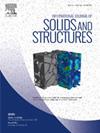Deformation and stability of initially stressed hyperelastic plates
IF 3.4
3区 工程技术
Q1 MECHANICS
International Journal of Solids and Structures
Pub Date : 2025-02-06
DOI:10.1016/j.ijsolstr.2025.113253
引用次数: 0
Abstract
Initial/residual stress is inherent in nearly all natural and engineered structures. This paper presents a comprehensive theory for modelling residually stressed, growing plates. By constructing a two-dimensional representation of three-dimensional solid mechanics, we avoid any need for prior assumptions about deformation fields. This approach reformulates both the initial stress fields and deformation gradients in three-dimensional space through planar quantities, yielding a set of plate equations that govern their interactions. This framework enables modelling of various naturally and artificially generated planar structures with residual stress and growth, such as plant leaves and additively manufactured plates.
To explore the wrinkling instabilities that often arise in such structures, we derive a principal solution for an initially stressed, growing plate supported by Winkler foundations. We then apply linear perturbation to examine bifurcation phenomena, solving the resulting governing equations analytically and computationally. The numerical scheme is validated with analytical results and shows promise for solving more geometrically complex instability problems.
初应力超弹性板的变形与稳定性
初始/残余应力是几乎所有自然和工程结构所固有的。本文提出了一个全面的理论,模拟残余应力,生长板。通过构造三维固体力学的二维表示,我们避免了对变形场的任何预先假设的需要。这种方法通过平面量在三维空间中重新表述了初始应力场和变形梯度,产生了一组控制它们相互作用的板块方程。这个框架可以对各种自然和人工产生的平面结构进行建模,这些结构具有残余应力和生长,例如植物叶片和增材制造的板。为了探索在这种结构中经常出现的起皱不稳定性,我们推导了由温克勒基础支撑的初始应力生长板的主解。然后,我们应用线性摄动来检查分岔现象,解析和计算解决由此产生的控制方程。数值格式与解析结果进行了验证,显示了求解更复杂几何不稳定问题的前景。
本文章由计算机程序翻译,如有差异,请以英文原文为准。
求助全文
约1分钟内获得全文
求助全文
来源期刊
CiteScore
6.70
自引率
8.30%
发文量
405
审稿时长
70 days
期刊介绍:
The International Journal of Solids and Structures has as its objective the publication and dissemination of original research in Mechanics of Solids and Structures as a field of Applied Science and Engineering. It fosters thus the exchange of ideas among workers in different parts of the world and also among workers who emphasize different aspects of the foundations and applications of the field.
Standing as it does at the cross-roads of Materials Science, Life Sciences, Mathematics, Physics and Engineering Design, the Mechanics of Solids and Structures is experiencing considerable growth as a result of recent technological advances. The Journal, by providing an international medium of communication, is encouraging this growth and is encompassing all aspects of the field from the more classical problems of structural analysis to mechanics of solids continually interacting with other media and including fracture, flow, wave propagation, heat transfer, thermal effects in solids, optimum design methods, model analysis, structural topology and numerical techniques. Interest extends to both inorganic and organic solids and structures.

 求助内容:
求助内容: 应助结果提醒方式:
应助结果提醒方式:


